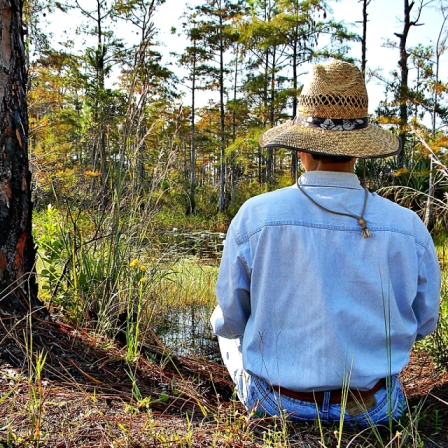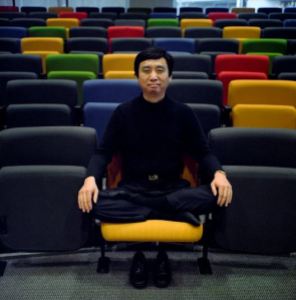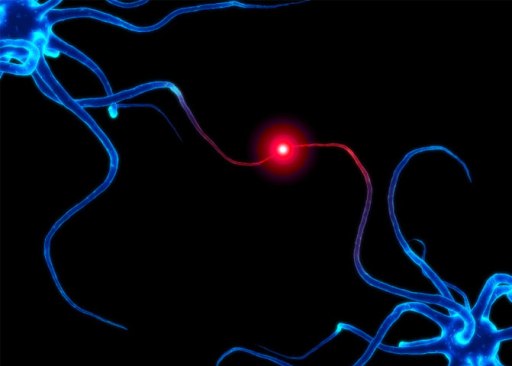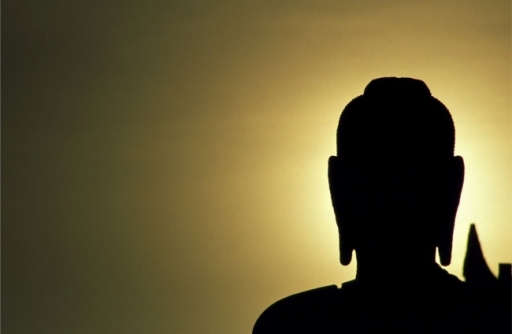If you listen carefully, you can hear multiple streams of mindfulness growing into a larger tide. Here are seven good reasons you might want to start surfing the mindfulness wave.
1) It’s simple.
Jon Kabat-Zinn, the founder of the famed Mindfulness Based Stress Reduction (MBSR) program at the University of Massachusetts-Worcester, has defined the practice as,
“Paying attention in a particular way, on purpose, in the present moment, with curiosity and kindness.”
Thich Nhat-Hanh, the Vietnamese Zen monk perhaps most responsible for the current surge of Buddhism in the west, chooses a more succinct definition, describing the technique as
“…keeping one’s consciousness alive to the present reality.”
In short, mindfulness means an active but gentle, kind and curious witnessing of what is—without preconception or wanting it to be otherwise.[1] It doesn’t take a lot of doing.

Mindfulness can be as easy as an afternoon by a pond.
The Meditation Pond, photo courtesy of Bob Peterson, North Palm Beach, Florida, Planet Earth.
While many practice mindfulness through some form of meditation—sitting, walking, yoga and the like—others boost their awareness by writing in a journal, making art, or paying close attention to the body’s experience during physical activity.[2] Still others just notice their inhalation and exhalation. You need no special equipment or expensive training. You can start in any location, from a mountaintop monastery to an inner-city subway. You can practice for the breadth of a long retreat or for the retreat of a long breath. No doubt, options range as widely as the people choosing them.
Whichever window into mindfulness you choose, the simple promise remains the same: opening any sliver of awareness will shed new light.
2) It works.
The incredible list of benefits from mindfulness practice reads like the high-gloss label on a bottle of modern-day snake oil:
Reduces blood pressure! Calms aggression! Eases pain!
Quells anxiety! Deepens sleep! Boosts the immune system!
Dissolves depression! Improves focus, attention, and memory!
Sharpens athletic and academic performance! Stimulates creativity!
Builds connection and compassion! Strengthens resilience!
Reduces substance abuse! Enhances motivation! Retrains the brain!
(Apply in all fields at all times for best results.)

Step right up! Really, *this* snake oil works!
Photo courtesy of David Loong, South Canberra, Australia.
Indeed, the sales pitch can sound like a stretch at best. Thing is, these claims aren’t bunk. More and more scientific studies prove them true every week.[3]
Whatever the mechanism behind the magic, whatever the dynamic that does the deed, paying closer attention to our experience brings a cartload of deep-reaching benefits.
Go back and read the list above again and soak it in. Really, go ahead. Mindfulness can blast you out of boredom and bring boldness to blandness. It will vitalize your senses and generate gratitude. It lives up to the sales pitch. It’s superfood for the mind and heart.
3) It’s everywhere.
Given the impact mindfulness has on well-being and performance, more and more institutions continue to commit themselves to developing specific, trainable techniques for their fields. Hospitals teach patients to manage their own hypertension and ease their own pain. Prisons help inmates calm and re-channel decades’ worth of anger. Schools generate greater interest in learning, dissolve disciplinary issues, and calm the stress of college applications.[4] Elite sports programs refine their athletes’ performances by sharpening the senses for chaotic environments.
Behind the work of Jolly Good Fellow Chade Meng Tan—yes, that is his official title—Google has become a trailblazer for mindfulness in the corporate world as well. Their internal “Search Inside Yourself” program still attracts waiting lists of employees clamoring to get in and has spawned a leadership institute (SIYLI, pronounced “silly”) to spread their methods far and wide. The program’s goals remain both simple and audacious: Achieve success, happiness, and world peace. Given the company’s reach and the corporate world’s increasing welcome of the message–look at Target, General Mills, Goldman Sachs and Green Mountain Coffee Roasters for further examples–they just might reach those goals.
The astute may notice the irony of allowing “what is” as a method of achieving even more. If you’re really practicing mindfulness, can you care about the outcome so much? It’s a fair question and one worth asking. Regardless of the answer—and I suspect the inquiry may drop us straight into the realm of capital “P” paradox—all these institutions aren’t waiting around or worrying. They’re finding success with mindfulness, however they define that success. And that’s enough to go on.[5]
4) It’s hard.
If mindfulness proves so beneficial, why don’t we teach this to every kid in every class? Why don’t all parents and bosses know about it? Why doesn’t everyone embrace it?
For one, mindfulness brings stuff up. When you pause the frantic drive to achieve, you start to notice what’s really happening. The grief of a lost child, the uncertainty of a violent world, the numbness of any addiction: such pains float to the surface when our emotional waters grow still. Mindfulness may give us tools to work through such challenges—namely by letting them be—but that makes them no less real. The same holds true on a wider-level: a community practicing mindfulness may come to see the ways in which they participate in perpetuating their own struggles. And that hurts too. It takes a certain strength to face the demons head-on.[6]
Mindfulness also takes discipline. Forces are lined up to keep us from staying fully present. Many (most?) corporations don’t want us waking up to what we really need and spend their advertising dollars to keep us all in a zombie-like state of consumption. Better we miss the abuses in the factory farm or pass by the cruelties in creating our clothes. Hollywood and the internet media spend millions to distract us with more overbloated blockbusters or addictive internet memes. Even governments that promote ‘transparency’ and ‘freedom’ would rather keep their reach under wraps. Better we stay frozen in some fear about our future than find promise in our present.
On a smaller level, our friends and bosses can resist change too. Anything new or different can seem a threat. It’s not just others that can block our progress, though. We, too, can get in our own way. Either we fall prey to our own internal hesitation or we create external turbulence by coming off as righteous or holier-than-thou. Yes, the growing tide of mindfulness may well wash away all such resistance, but for now, fighting all these forces—inside and out—still demands enough resilience to swim upstream.
5) It’s an antidote to our turbo-charged, multi-tasking illness.
I know very few people who don’t feel too busy or too overwhelmed with the amount of responsibility they carry and information they try to process—and I live in a sleepy, rural town of 3,000. Technology keeps promising to simplify our lives but instead makes them more demanding. Cell phones and wireless coverage reach further and further into previously private spaces so we’re always reachable and, as the NSA knows too well, always trackable. Rather than simply enjoying what’s in front of us—say, a movie—we gobble for more, following the director’s notes on the tablet while we leaf aimlessly through e-mail on a laptop or send status updates by smartphone. God forbid we’re trying to study or grade papers or write a blog post.
A different kind of technology, the practice of mindfulness cuts through the clatter of such multi-tasking and virtual reality, bringing us back to a body-based experience rooted firmly in place and time. Our renewed focus means we actually get more done and we can enjoy ourselves while we do it. We come back from the edge of hyper-drive and slow down to a healthier human speed.
As the Irish priest John O’Donohue wrote in his poem “A Blessing for One Who is Exhausted,”:
…You have traveled too fast over false ground; Now your soul has come to take you back. Take refuge in your senses, open up To all the small miracles you rushed through…. Gradually, you will return to yourself, Having learned a new respect for your heart And the joy that dwells within slow time.[7]6) It will change your brain.
I mentioned this well-researched fact earlier when covering the benefits of mindfulness but it bears repeating. The more time we spend cultivating attention and compassion, the more attentive and compassionate we become. We build gray matter density in the hippocampus—the area most responsible for learning and memory—and decrease density in the amygdala, the area responsible for stress and anxiety responses.[8] We form new neural pathways that build our capacity.
Of course, neuroplasticity holds true in the other direction as well. The brain changes form to accommodate whatever choices we make. If we “practice” aggression, anxiety, and reactivity, that’s the pattern we develop. Which path will we choose?
7) You don’t need to believe anything.
Yes, mindfulness meditation derives from yogic and religious practices developed in India and East Asia thousands of years ago, but you don’t have to follow the Buddha or any god to reap its rewards.
Partly that’s because modern-day teachers of mindfulness like Kabat-Zinn have translated the practice into secular terms. One can develop “focused attention”—i.e., simply noticing when concentration drifts from a particular point (the breath, the body, a tree) and then gently bringing concentration back to that point—without adhering to the Four Noble Truths. One can foster “open monitoring”—a soft, non-judgmental awareness of whatever thoughts or feelings pass by—without committing to the Eight-Fold Path. Scientific research backs the practice up. No religious support needed.[9]
It’s also because the Buddha wouldn’t have wanted you to take his word for it, even if you were a follower. Make of yourself a light, he said as his followers asked for a last bit of wisdom while he lay on his death bed. [10] In other words, find the same truth yourself. Run your own experiments. Observe your own experience. The Buddha taught mindfulness meditation, among his many other lessons without teaching “Buddhism.” You can learn it that way too.
[1] If the idea of mindfulness still seems elusive, consider the more approachable definition of mindlessness: that numb, glazed-over auto-pilot where we give little or scattered attention to what’s happening right in front of us. The state where we pay passing heed—if any—to the consequences of our behavior. Then figure its opposite. Where mindlessness means numbness, mindfulness means feeling, noticing, experiencing. Where mindlessness suggests a hazy surrender of our own responsibility, mindfulness indicates an intention to stay sharp, focused, and conscious of the influence we have. It’s being here, now.
[2] Though mindfulness can serve as a form of meditation and vice versa—and folks often use the words interchangeably in public conversation—they overlap more than mirror each other. The same is true for contemplation, the usually quiet practice of considering experience with open, honest questions and waiting for insight or direction. Mindfulness can function as contemplation, in essence asking the honest question “What am I experiencing in this moment?” But contemplation could also explore wider, non-local, future- or past-oriented inquiries as well.
[3] For scientific research that backs these claims up, click on the respective link connected to the following claims. Reduces blood pressure! Calms aggression! Eases pain! Quells anxiety! Deepens sleep! Boosts the immune system! Dissolves depression! Improves focus, attention and memory! Sharpens athletic and academic performance! Stimulates creativity! Builds connection and compassion! Strengthens resilience! Reduces substance abuse! Enhances motivation! Retrains the brain!
[4] Check out the South Burlington, Vermont school district; the Bay School in San Francisco, and the Middlesex School in Massachusetts for some striking examples.
[5] I suspect that, over time, the wider practice of mindfulness will actually lead more of our institutions to shift their focus—at least somewhat—from profit, growth and achievement to wellness, community service, and personal development.
[6] Many dismiss mindfulness in the school or in the workplace as “woo-woo,” as if sitting in silence for a moment or ringing a chime could somehow transform you into a New Age crystal-toting caricature. To my ear, that’s another way of saying “This gets me in touch with my emotions and makes me uncomfortable. I’m afraid to feel vulnerable so I’ll belittle the experience instead.”
[7] ©John O’Donohue, To Bless the Space Between Us (New York: Doubleday, 2008), p.125, 126. Drawn from http://www.transformingcenter.org/2010/08/a-blessing-for-one-who-is-exhausted/.
[8] Christie Nicholson of Scientific American, as linked to at http://www.modernmeditation.ca/your-brain/.
[9] Of course, I don’t mean to imply that the rigorous discipline and time-tested wisdom of Buddhism and yogic practices—among the more meditative traditions—don’t add to the benefits of mindfulness training. They can provide an even wider foundation and perspective on the teachings.
[10] See Mary Oliver’s poem “The Buddha’s Last Instruction” for a gorgeous rendering of that exquisite moment.






Thank you for this beautiful post. I needed this reminder…
Thank you, Jenny. I’m glad it resonated for you.
Cool to see you’re monitoring your blog at 2:39am.
Must have been during one of those mindfulness sessions 🙂
Love,
Dad
I’ve shared your post on G+, I hope that’s ok with you!
Totally fine! Thanks for passing it along.
Excellent post – I’d really like to link it to my website: its an excellent reference and I’m constantly using Mindfulness as a foundational practice for much of my work.
Also would really like to do one of your improv workshops, wun ov these days.
Thanks so much
Allan
Thank you for your kind words, Allan. Feel free to link the post to your website and we’d be delighted to have you at our workshop. Hopefully I’ll get to meet you soon!
Ted